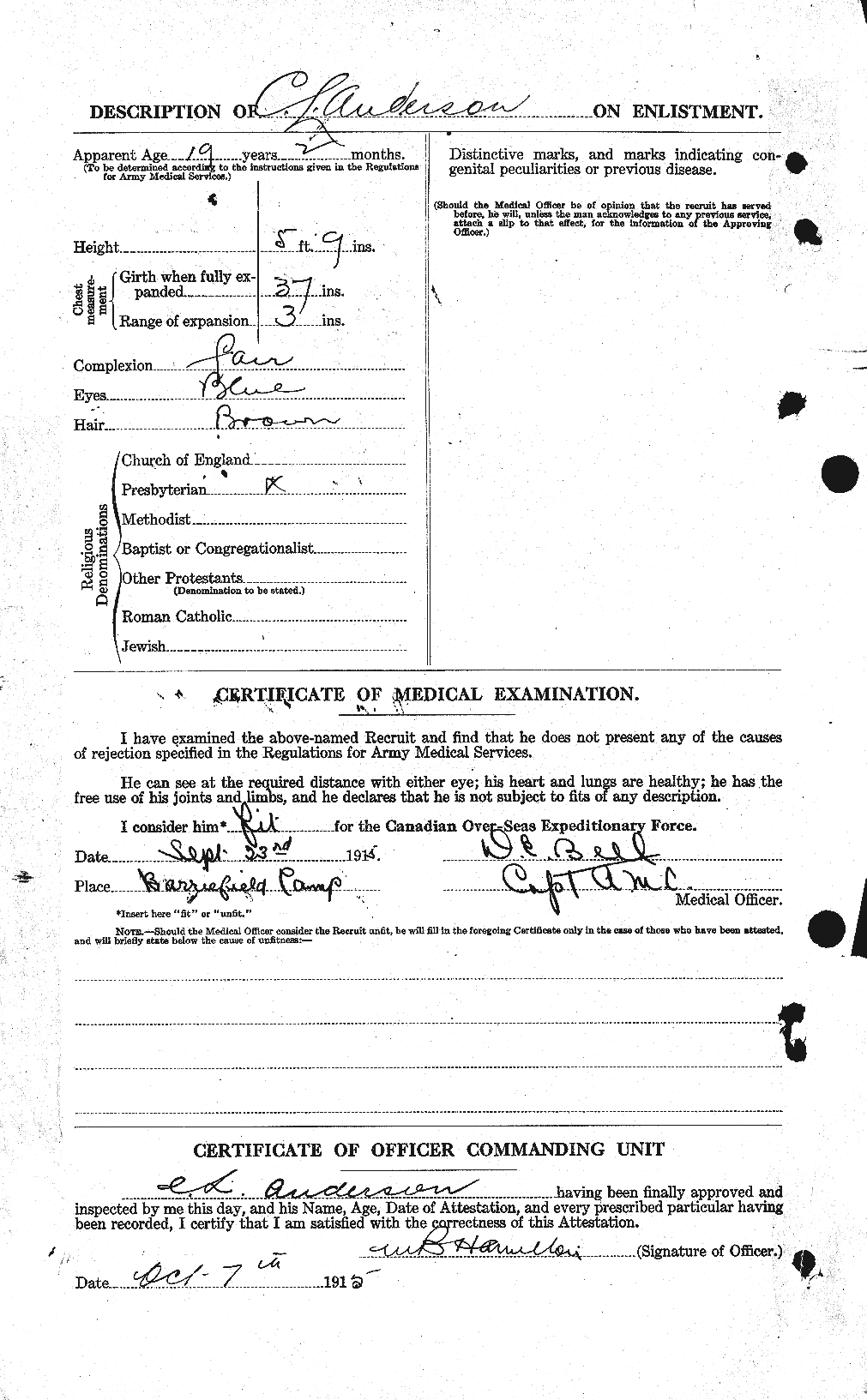

Charles Laidlaw Anderson

Charles Laidlaw Anderson was a private during the First World War, which lasted from August 1st 1914 to November 11th 1918, a total of four years. Charles Laidlaw Anderson was born on September 21, 1986, in Port Hope, Ontario. He was born to Mr. Thos L. Anderson and Mrs. Mary Jane Anderson. He lived on 516 Water Street, Peterborough with his parents.
At the time of enlistment, Charles was nineteen years and two months old. He was a tall youth; five feet nine inches, and 145 lbs. He was of fair complexion, with brown hair and blue eyes. Before enlisting for the army, Charles was a student at the University of Toronto. He was not married before the war, nor did he have any siblings.
Prior to joining the war, Charles was a part of the 24th Battery, which was an army artillery unit. He enlisted for the first world war on September 11, 1915, in Barriefield. His first unit was the 11th Rs. Bn. and was then transferred overseas to the P. P. C. L. I. (Princess Patricia’s Canadian Light Infantry). He was given the rank of a private and his regiment number was 475533. On enlistment, he was a part of the 17th. Res. Battn. His record group was the Canadian Expeditionary Force (CEF).
Charles died on June 1st 1916. He was possibly killed during the Battle of Mont Sorrel as records show that the P. P. C. L . I. was one of the infantry units fighting at that battle, which he was a part of. He was reported as ‘killed in action’, with no further details.
Charles is buried in Belgium, at the Railway Dugouts Burial Ground, with grave reference VI. D. 58. He is buried under a white tombstone with a carving of a maple leaf. The gravesite is located 2 km southeast from the Ieper town center. He is commemorated on page 46 of the First World War Book of Remembrance.





Attestation papers of Charles Laidlaw Anderson
We Shall Keep the Faith
by Moina Michael, November 1918
Oh! you who sleep in Flanders Fields,
Sleep sweet - to rise anew!
We caught the torch you threw
And holding high, we keep the Faith
With All who died.
We cherish, too, the poppy red
That grows on fields where valor led;
It seems to signal to the skies
That blood of heroes never dies,
But lends a lustre to the red
Of the flower that blooms above the dead
In Flanders Fields.
And now the Torch and Poppy Red
We wear in honor of our dead.
Fear not that ye have died for naught;
We'll teach the lesson that ye wrought
In Flanders Fields.
Charles' gravestone
A photo of Charles Laidlaw Anderson, rare to be found.

Close up of commemoration in the First World War Book of Remembrance
Charles' commemoration on page 46 of the First World War Book of Remembrance


Letter from Charles to his mother, Mrs. Mary Jane Anderson
By: Anjali Rawal


Poem found on greatwar.co.uk
War Propaganda:
Before most soldiers enlisted for the First World War, they were influenced greatly by the war spirit and propaganda. Propaganda encouraged soldiers to enlist in the army by making the life of a post-war veteran or soldier seem appealing, or by showing how brutal the Germans were. University students, like Charles, during this time were influenced by these messages, which added to their willingness and excitement to join the war effort.
Letter from Mrs. Mary Jane Anderson to her son, Charles
By: Anjali Rawal
-Additional Information-
'A Pittance of Time' by Terry Kelly
Remembering the soldiers who have fought in war

War Art
Canadians at Ypres
By: William Barnes-Wollen (1915)

Making Soldier in the Trenches
By: Eric Kennington
(1917)
The Author of We Shall Keep the Faith
Moina Michael, born August 15, 1869, was an American professor, as well as a humanitarian. She had the idea of using poppies for those who served and died during the war. They were and still are a widely known symbol of remembrance. Moina wrote a poem called 'We Shall Keep the Faith' (see above). After reading John McCrae's poem, 'In Flanders' Fields', she decided to wear a poppy at all times to remember the people who served in the war. She is now known as the "poppy lady". Moina died on May 10, 1944.